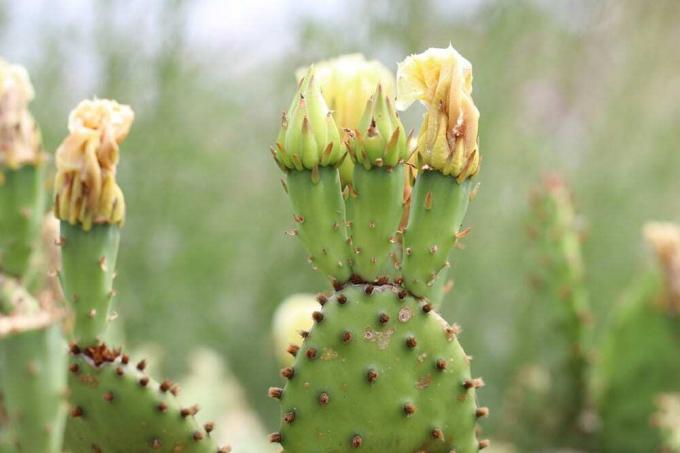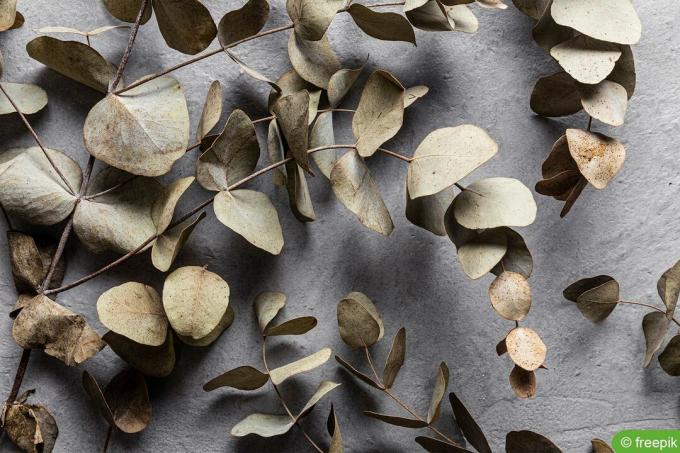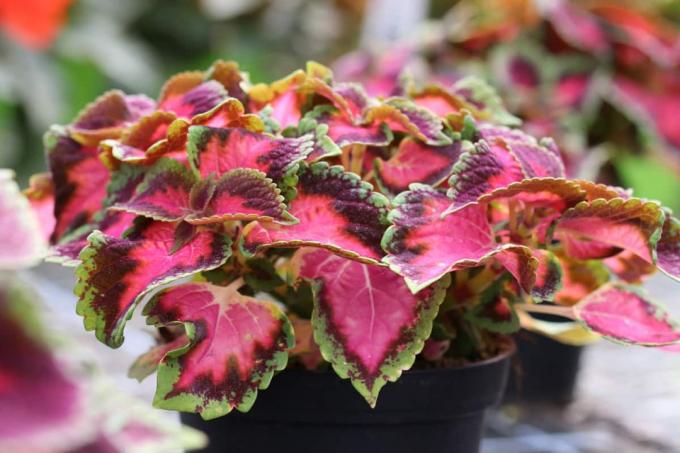

Table of contents
- Do cacti tolerate frost?
- Hardy varieties
- variety selection
- site selection
- rain protection
- cover
- water reduction
- fertilizer
- Overwinter cacti in tubs
Cacti are not part of the typical landscape in this country. Nevertheless, they are often welcome guests in our houses and gardens. They inspire with their unusual growth and bright flowers. The variety of varieties knows no limits. The passion for collecting is quickly ignited. These undemanding plants get by with little maintenance. But do they survive icy winters outdoors? After all, they are known as desert dwellers.
Do cacti tolerate frost?
In our imagination, cacti and desert are inseparable. There, where the sun burns tirelessly and the rain is extremely rare. Where frost is an unknown word. True, some types of cacti actually come from these inhospitable sandy areas, but by no means all. For example, there are leaf cacti that prefer tropical rainforests. However, they do not know any frost in their homeland either. Both desert cacti and the rainforest specimens cannot tolerate sub-zero temperatures, which are an integral part of winter for us. They belong in the bucket, and in winter they definitely belong in the house.
But there are still a few survivors from the cactus family that grow in the high Andes or mountains of North America. These mountain species are used to the cold and are accordingly frost hardy. We also allow them to grow outside all year round.
Hardy varieties
In the large cactus family are some beautiful varieties that do well in frost. Even temperatures down to minus 25 degrees do not bother these desert dwellers much. Provided, of course, that their requirements in terms of location and care are optimally met at all times. The hardy species include hedgehog columnar cacti (Echinocereus), spherical cacti (Escobaria) and prickly pear cacti (Opuntia). Among them, the following varieties are particularly recommended in this country:
- Echinocereus adustus
- Echinocereusbaileyi
- Echinocereus caespitosus
- Echinocereus coccineus
- Echinocereus inermis
- Escobaria missouriensis
- Echinocereus viridiflorus
- Escobaria arizonica
- Escobaria orcuttii
- Escobaria sneedii
- Escobaria vivipara
- Opuntia phaeacantha
- Opuntia fragilis
- Opuntia rhodantha
- Cylindropuntia imbricata (columnar)
variety selection

Overwintering cacti outdoors can only succeed if they are frost-hardy varieties. All other types of cacti would not survive icy winters outside. Caution is advised even in mild, frost-free winters. Even if the cactus should survive the winter, at least growth and flowering will suffer. Hardy cactus varieties are therefore a must for anyone who does not have suitable winter quarters. If you don't know which varieties are growing in front of you, you should clarify this in good time before the onset of winter. You could, for example, ask in specialist shops or research on the Internet. In the future, only buy cacti that are hardy for outdoors.
A notice:
When buying new cacti, be sure to pay attention to their "past life". Hardy cactus varieties that only live in greenhouses are not sufficiently hardy. The information "hardy" on the label is of little use.
site selection
In order for a hardy cactus to survive the cold winter really well, winter hardiness is of course an important criterion. In addition, the prickly desert dweller needs good living conditions all year round to develop into a strong, resilient plant. Only then can he brave the cold and come into the new season unscathed. Good care also includes the optimal location.
- sunny
- protected from wind and rain
- Water must be able to drain well
- possibly. create a drainage layer
- planting out on a slope also prevents moisture
- a small mound can also be created
Cacti don't like wet feet, then they rot quickly. Waterlogging is particularly dangerous in winter, as the frozen water damages the roots.
Tip:
Subsequent location optimization is definitely possible. Either the cactus is transplanted to a more suitable location. Or a drainage layer is added later.
rain protection
Some types of cacti must not be left unprotected to the rain in winter, otherwise they will lose their winter hardiness. This includes:
- Hedgehog columnar cactus hybrids
- such as octacanthus and viridiflorus
- Cactus from the genus Gymnocalycium
- Hybrids of Opuntia and Escobaria wild species

These cacti may be planted outdoors and remain there all year round. However, they need a protective roof over their heads that will keep most of the rain off of them.
- a location under a canopy is ideal
- alternatively also a superstructure
- Wooden posts form the supporting structure
- Greenhouse film is ideal as a cover
- two sides should remain open
- this ensures sufficient air exchange
cover
In the fall, most native plant species are covered with a layer of brushwood or mulch. However, cacti also need a lot of light in winter, so they should not be covered. Anything that will keep the root area wet, such as nearby dead plant debris, should also be avoided. Snow as a cover, on the other hand, is welcome. It protects the cactus from extreme cold and moisture. A layer of snow can safely remain on the ground. Even if the cactus underneath completely disappears. Only the condensation water can lead to problems. It is therefore important that this can always drain well.
water reduction
Cacti store plenty of water in their trunks and sometimes also in their leaves. This is very important for the survival of the cacti in the warm season. In winter, however, too much water can have catastrophic effects. Water freezes at zero degrees and expands. The bulging cacti would freeze to death so quickly. Therefore, the water supply must be adjusted early to the approaching winter.
- start with water reduction as early as August
- gradually water less
- stop watering from September
With each passing day, the cacti will look more and more shriveled and will eventually hang flat on the ground. Now it's time: Don't panic! And don't reach for the watering can! Even if the beloved cacti are not a pretty sight, there is no need to worry. The pathetic appearance is not a result of thirst for water. Rather, it is a successful strategy for surviving the cold winter without suffering frostbite. In spring, as soon as the temperatures rise noticeably again, the water supply can be resumed. The cacti recover surprisingly quickly from the hardships of winter. The new addition of water irons the wrinkled skin smooth again.
A notice:
To protect against frost, the cacti store salt and other substances and thus lower the freezing point. The deposited substances cause a discoloration of the cacti. This brownish discoloration is not harmful and will disappear on its own in the spring.
fertilizer

The cacti hibernate during the cold season. During this time, growth stops completely. This must be taken into account when fertilizing.
- Stop fertilizing from autumn
- do not fertilize at all during the entire dormant period
- don't start fertilizing again until spring
A notice:
By the way, cacti are special plants that usually grow slowly. They need a special fertilizer that covers their needs.
Overwinter cacti in tubs
Cacti and terracotta pots are a particularly decorative combination. That's why cacti are often planted in it, but also in all other possible buckets. When autumn is coming to an end, the potted plants are moved to frost-free quarters. For most plants, including most cacti, this is a life-saving measure. But not for the hardy cacti. For these cactus species, the cold period is part of healthy growth. After that, the flower is all the more lush and beautiful. If you put them in a warm winter quarters, these cacti would suffer.
- hardy cacti may/must overwinter outdoors
- but need protection
- Stop fertilizing and watering
- set up protected from rain and wind
- under a canopy
- Place bucket on styrofoam and wrap with fleece
- Do not wrap cactus as it needs light
- in the spring the protection can be removed again
Tip:
Even in severe frost, do not bring the buckets into the house. In the warmth, the cacti could start to grow. This leads to weak and pale shoots. If you put it outside again, there is also a risk of frostbite, since the adaptation to winter cold is weakened by the warm "excursion".
 garden editorial
garden editorial I write about everything that interests me in my garden.
Learn more about overwintering plants

Eucalyptus dries up during the winter: what to do?
Eucalyptus in tubs spends the winter best in a frost-protected place in the house. It is not uncommon for the beautiful eucalyptus plants to dry up during the winter. We show what you can do about it.

Is bamboo hardy? Hibernate bamboo correctly
A bamboo can undoubtedly enrich any garden. But can it survive winter temperatures in good health? There is no general answer. It depends on the species and what winter protection it gets.

Is the colored nettle hardy? 6 tips for wintering
Summer is the season when the colors of these ornamental foliage plants are at their most intense. Most of the leaves are multicolored, with different drawings, wavy or heavily slit edges.

Is Camellia japonica hardy? Overwinter camellia properly
Anyone who sees a blooming camellia for the first time will definitely be amazed. The attractive plant, which came to Central Europe from Japan and Korea, has taken the hearts of hobby gardeners by storm. It is usually cultivated in tubs. Is she hardy?

Is the magic flower hardy? | Overwinter Mirabilis jalapa
The Japanese miracle flower (Mirabilis jalapa) delights its viewers with its bright and colorful flowers from June to October. It carries up to five different colored flowers on one and the same plant. Even a single flower can be multicolored.

Is rhododendron hardy? 6 tips for wintering
Overwintering rhododendrons: With these 6 tips you can get the azaleas through the winter safely!



